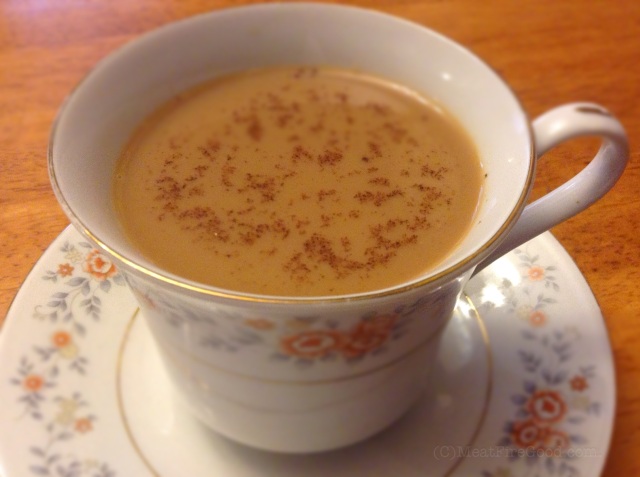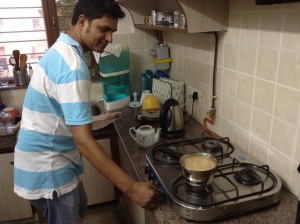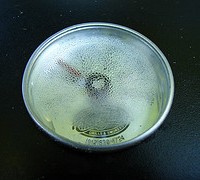
Chai Masala, a utterly sublime end to a fantastically flavorful meal.
Chai is a staple in Indian cuisine and frankly, no one knows how to do it better than they do. If you are an American who has sampled the various commercially produced chai mixes in tea bags or sampled some from your local barista, then you likely have been missing out on the unbelievably flavorful and satisfying chai masala made the traditional Indian way.
Ingredients
Masala is simply a term for spice blend, and chai masalas vary depending on household recipes. Cardamom, cinnamon, cloves, ginger, and ground black pepper are frequent ingredients. To really enjoy authentic chai, you will need to either make or purchase some chai masala. But don’t stress over details– one could simply mix a small amount of whatever of these ground/powdered ingredients you have handy, going heavy on the ginger and pepper. Here is one recipe but about 1.2 billion variations abound: http://tinyurl.com/kep25ce
 The essentials for authentic chai masala include the right tea, freshly crushed green cardamom, fresh ginger, milk, and sugar. There is a clear choice of tea for making chai and it is Assam Mamri. This is a full-flavored granular loose tea that withstands the spices without being overpowering or too bitter. Although others say to use whatever black tea you can find, I would not trust a word they say .
The essentials for authentic chai masala include the right tea, freshly crushed green cardamom, fresh ginger, milk, and sugar. There is a clear choice of tea for making chai and it is Assam Mamri. This is a full-flavored granular loose tea that withstands the spices without being overpowering or too bitter. Although others say to use whatever black tea you can find, I would not trust a word they say .
That’s right. Settling for anything else is just wrong. It is living life out of balance and tempting fate. Friends don’t let friends drink lousy chai. You can likely get a large bag of Assam Mamri at your local world food market for about three dollars, along with the other ingredients such as cardamom and a chai masala blend.
Fresh green cardamom pods (perhaps the most heavenly spice known to man) are cracked open with a mortar and pestle (a flat-bottomed juice glass on a saucer can work in a pinch) and steeped in the heating water. Either squeezed or grated ginger fill out a fragrant and flavorful pot of chai.
The milk is cooked in the chai providing yet another flavor component not accustomed to by most Americans. I use 2% but my friend Gopal in Delhi uses skim. Lastly, chai is best served sweet, and one will usually find 2-3 times the amount of sugar on the typical table in India than in America. You know– sugar and spice!
Lastly, you will also need a way to strain the loose ingredients, usually when poured into your teapot.
Directions
Let’s get down to business! Here is what I do:
In a medium saucepan, pour four coffee-cups full of water. Add about 1/2 teaspoon of chai masala (a pinch per cup) and about 2″ of a cinnamon stick to the water as it heats on high. With a mortar and pestle, crack open one green cardamom pod per cup of water and add to the heating water– husks and all. Especially in the winter, you must include fresh ginger. For a pot of 4 cups, I use about a large grape size piece of ginger. Ideally, you squeeze the juice out with something like a garlic press, but it is much easier and almost as effective to use a grater instead of squeezing it; simply grate it right into the heating pot of water. You can also dice the ginger and then smash it with a mortar and pestle before adding to the heating water. Then, add one rounded teaspoon of Assam Mamri tea per coffee cup to the pot (if using teacups instead of coffee cups, use one level teaspoon of tea per cup). Breather in the unbelievably alluring fragrance as it heats. THIS is the spice of life.
You then bring the lovely elixir to a boil. That’s right, a full boil. No, it won’t get bitter with tannins if you follow the steps below. It must be Indian magic because it works amazingly well. As soon as it comes to a boil, you reduce the heat to low, then pour in milk. One determines the amount of milk by the heavenly color of the chai. I have never measured it but I would guess that about 1/2 cup would be a good starting point. Then, watch it carefully as you bring it to a gentle boil three times, turning down the heat and letting it sit for about 30 seconds after each boil. After the third boil with milk, turn off the heat and allow the ingredients to settle for about a minute or two. The volume of milk added makes up for the amount of water that evaporates and is soaked up by the dry ingredients. Next, carefully pour the chai through a strainer into your teapot. Yes, it takes practice and you might spill the first time or two, but you will get it.
Serve this heavenly concoction with 2 teaspoons of sugar per cup. As one Indian friend told me, the only way to drink chai is sweet!
Namaste!







